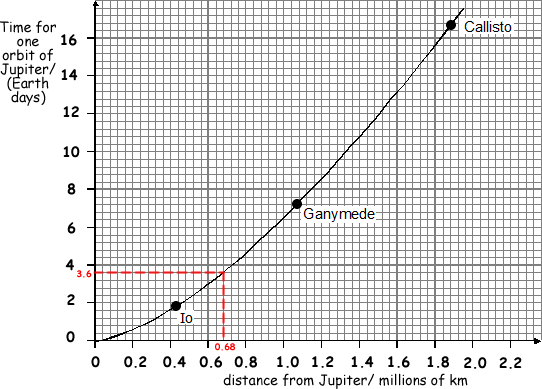Questions on the Earth in Space
 Q19. In 1610, the Italian scientist, Galileo, observed four bright moons near Jupiter. Each night the moons had moved.
Q19. In 1610, the Italian scientist, Galileo, observed four bright moons near Jupiter. Each night the moons had moved.
(a)
(i) The Sun and stars are light sources, and the planets are seen by reflected light. Explain how we can see the moons of Jupiter.
Light from the Sun  is reflected from the moons’ surfaces
is reflected from the moons’ surfaces  and then travels through space to our eyes
and then travels through space to our eyes 
Do not accept ‘light from the Sun and stars’
Do not accept ‘the Sun reflects off the surface’
3 marks
(ii) The four moons are approximately the same distance from the Earth. However, they do not have the same brightness. Suggest one reason for this.
- they reflect different amounts of light or some absorb more of the sunlight than others. Accept: 'they have different albedos' or a 'some are darker' or 'they are different colours'

- they are not the same size. The larger moons will reflect more light and look brighter.

- one could be partly in the shadow of Jupiter or another moon.

1 mark max
(b) The table below shows the distances of the four moons from the centre of Jupiter, and the times of their orbits. (Europa's distance has been left out).
name of
moon |
distance from
Jupiter, in
millions of km |
time for one
orbit, in
Earth days |
Io |
0.42 |
1.8 |
Europa |
|
3.6 |
Ganymede |
1.07 |
7.2 |
Callisto |
1.88 |
16.7 |
The graph below was plotted using the information in the table. Use the graph to estimate Europa's distance from Jupiter.

Europa is 0.68 million kilometres from Jupiter. 
1 mark
(c) Galileo realised that Jupiter and its moons formed a model of our Solar System. In this model:
(i) what did Jupiter represent? the Sun (or our star - Sol) 
(ii) what did the moons represent?the planets 
2 marks
Maximum 7 marks


